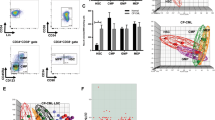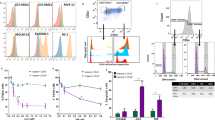Abstract
In vitro studies demonstrating the induction of programmed cell death by cytotoxic drugs used in anticancer chemotherapy suggested that antileukemic treatment eliminates leukemia cells by apoptosis. We therefore analyzed apoptosis induction and activation of apoptosis signaling molecules in patients receiving remission induction treatment for AML and ALL during the initial phase of leukemia cell reduction. A coexistence of distinct populations of CD34+ and CD34− leukemia cells could be identified. During chemotherapy, CD34+ leukemia cells were more rapidly depleted than CD34− cells. Furthermore, a significant increase in leukemia cell apoptosis ex vivo was detected in CD34+ cells, while no such increase was observed in the CD34− subpopulation, suggesting that CD34+ leukemia cells are the main targets for apoptosis induction through antileukemic treatment. No alterations in Bax and Bcl-2 expression were found during in vivo chemotherapy, and CD95 expression and sensitivity remained low, indicating the induction of apoptosis independent of the CD95 system or regulation of protein levels of Bax and Bcl-2. The data suggest that analysis of leukemia cell subpopulations is required for further identification of apoptosis signaling molecules relevant for response to treatment and assessment of drug efficacy in vivo and in vitro.
This is a preview of subscription content, access via your institution
Access options
Subscribe to this journal
Receive 12 print issues and online access
$259.00 per year
only $21.58 per issue
Buy this article
- Purchase on Springer Link
- Instant access to full article PDF
Prices may be subject to local taxes which are calculated during checkout







Similar content being viewed by others
References
Dive C, Evans CA, Whetton AD . Induction of apoptosis – new targets for cancer chemotherapy. Semin Cancer Biol 1992; 3: 417–427.
Hannun YA . Apoptosis and the dilemma of cancer chemotherapy. Blood 1997; 89: 1845–1853.
Los M, Herr I, Friesen C, Fulda S, Schulze-Osthoff K, Debatin KM . Cross-resistance of CD95- and drug-induced apoptosis as a consequence of deficient activation of caspases (ICE/Ced-3 proteases). Blood 1997; 90: 3118–3129.
Decaudin D, Geley S, Hirsch T, Castedo M, Marchetti P, Macho A et al. Bcl-2 and Bcl-XL antagonize the mitochondrial dysfunction preceding nuclear apoptosis induced by chemotherapeutic agents. Cancer Res 1997; 57: 62–67.
Kim CN, Wang X, Huang Y, Ibrado AM, Liu L, Fang G et al. Overexpression of Bcl-X(L) inhibits Ara-C-induced mitochondrial loss of cytochrome c and other perturbations that activate the molecular cascade of apoptosis. Cancer Res 1997; 57: 3115–3120.
Friesen C, Herr I, Krammer PH, Debatin KM . Involvement of the CD95 (APO-1/FAS) receptor/ligand system in drug-induced apoptosis in leukemia cells. Nat Med 1996; 2: 574–577.
Belaud-Rotureau MA, Durrieu F, Labroille G, Lacombe F, Fitoussi O, Agape P et al. Study of apoptosis-related responses of leukemic blast cells to in vitro anthracycline treatment. Leukemia 2000; 14: 1266–1275.
Wen J, Ramadevi N, Nguyen D, Perkins C, Worthington E, Bhalla K . Antileukemic drugs increase death receptor 5 levels and enhance Apo-2L-induced apoptosis of human acute leukemia cells. Blood 2000; 96: 3900–3906.
Campos L, Sabido O, Viallet A, Vasselon C, Guyotat D . Expression of apoptosis-controlling proteins in acute leukemia cells. Leukemia Lymphoma 1999; 33: 499–509.
Svingen PA, Karp JE, Krajewski S, Mesner Jr PW, Gore SD, Burke PJ et al. Evaluation of Apaf-1 and procaspases-2, -3, -7, -8, and -9 as potential prognostic markers in acute leukemia. Blood 2000; 96: 3922–3931.
Estrov Z, Thall PF, Talpaz M, Estey EH, Kantarjian HM, Andreeff M et al. Caspase 2 and caspase 3 protein levels as predictors of survival in acute myelogenous leukemia. Blood 1998; 92: 3090–3097.
Lauria F, Raspadori D, Rondelli D, Ventura MA, Fiacchini M, Visani G et al. High bcl-2 expression in acute myeloid leukemia cells correlates with CD34 positivity and complete remission rate. Leukemia 1997; 11: 2075–2078.
Campos L, Rouault JP, Sabido O, Oriol P, Roubi N, Vasselon C et al. High expression of bcl-2 protein in acute myeloid leukemia cells is associated with poor response to chemotherapy. Blood 1993; 81: 3091–3096.
Maung ZT, MacLean FR, Reid MM, Pearson AD, Proctor SJ, Hamilton PJ et al. The relationship between bcl-2 expression and response to chemotherapy in acute leukaemia. Br J Haematol 1994; 88: 105–109.
Karakas T, Maurer U, Weidmann E, Miething CC, Hoelzer D, Bergmann L . High expression of bcl-2 mRNA as a determinant of poor prognosis in acute myeloid leukemia. Ann Oncol 1998; 9: 159–165.
Tsurusawa M, Saeki K, Katano N, Fujimoto T . Bcl-2 expression and prognosis in childhood acute leukaemia. Children's Cancer and Leukemia Study Group. Pediatr Hematol Oncol 1998; 15: 143–155.
Kaufmann SH, Karp JE, Svingen PA, Krajewski S, Burke PJ, Gore SD et al. Elevated expression of the apoptotic regulator Mcl-1 at the time of leukemic relapse. Blood 1998; 91: 991–1000.
Borg AG, Burgess R, Green LM, Scheper RJ, Yin JA . Overexpression of lung-resistance protein and increased P-glycoprotein function in acute myeloid leukaemia cells predict a poor response to chemotherapy and reduced patient survival. Br J Haematol 1998; 103: 1083–1091.
Wuchter C, Karawajew L, Ruppert V, Buchner T, Schoch C, Haferlach T et al. Clinical significance of CD95, Bcl-2 and Bax expression and CD95 function in adult de novo acute myeloid leukemia in context of P-glycoprotein function, maturation stage, and cytogenetics. Leukemia 1999; 13: 1943–1953.
Filipits M, Stranzl T, Pohl G, Heinzl H, Jager U, Geissler K et al. Drug resistance factors in acute myeloid leukemia: a comparative analysis. Leukemia 2000; 14: 68–76.
Banker DE, Groudine M, Norwood T, Appelbaum FR . Measurement of spontaneous and therapeutic agent-induced apoptosis with BCL-2 protein expression in acute myeloid leukemia. Blood 1997; 89: 243–255.
Ong YL, McMullin MF, Bailie KE, Lappin TR, Jones FG, Irvine AE . High bax expression is a good prognostic indicator in acute myeloid leukaemia. Br J Haematol 2000; 111: 182–189.
Hogarth LA, Hall AG . Increased BAX expression is associated with an increased risk of relapse in childhood acute lymphocytic leukemia. Blood 1999; 93: 2671–2678.
Kornblau SM, Vu HT, Ruvolo P, Estrov Z, O'Brien S, Cortes J et al. BAX and PKCalpha modulate the prognostic impact of BCL2 expression in acute myelogenous leukemia. Clin Cancer Res 2000; 6: 1401–1409.
Wuchter C, Karawajew L, Ruppert V, Schrappe M, Harbott J, Ratei R et al. Constitutive expression levels of CD95 and Bcl-2 as well as CD95 function and spontaneous apoptosis in vitro do not predict the response to induction chemotherapy and relapse rate in childhood acute lymphoblastic leukaemia. Br J Haematol 2000; 110: 154–160.
Min YH, Lee S, Lee JW, Chong SY, Hahn JS, Ko YW . Expression of Fas antigen in acute myeloid leukaemia is associated with therapeutic response to chemotherapy. Br J Haematol 1996; 93: 928–930.
Iijima N, Miyamura K, Itou T, Tanimoto M, Sobue R, Saito H . Functional expression of Fas (CD95) in acute myeloid leukemia cells in the context of CD34 and CD38 expression: possible correlation with sensitivity to chemotherapy. Blood 1997; 90: 4901–4909.
Matsubara K, Kubota M, Adachi S, Kuwakado K, Hirota H, Wakazono Y et al. Induction of apoptosis in childhood acute leukemia by chemotherapeutic agents: failure to detect evidence of apoptosis in vivo. Eur J Haematol 1994; 52: 47–52.
Stahnke K, Fulda S, Friesen C, Strauss G, Debatin KM . Activation of apoptosis pathways in peripheral blood lymphocytes by in vivo chemotherapy. Blood 2001; 98: 3066–3073.
Liu T, Raetz E, Moos PJ, Perkins SL, Bruggers CS, Smith F et al. Diversity of the apoptotic response to chemotherapy in childhood leukemia. Leukemia 2002; 16: 223–232.
Bonnet D, Dick JE . Human acute myeloid leukemia is organized as a hierarchy that originates from a primitive hematopoietic cell. Nat Med 3: 730–737.
Lapidot T, Sirard C, Vormoor J, Murdoch B, Hoang T, Caceres-Cortes J et al. A cell initiating human acute myeloid leukaemia after transplantation into SCID mice. Nature 1994; 367: 645–648.
Blair A, Hogge DE, Sutherland HJ . Most acute myeloid leukemia progenitor cells with long-term proliferative ability in vitro and in vivo have the phenotype CD34(+)/CD71(−)/HLA−DR−. Blood 1998; 92: 4325–4335.
Wittebol S, Raymakers R, van de Locht L, Mensink E, de Witte T . In AML t(8;21) colony growth of both leukemic and residual normal progenitors is restricted to the CD34+, lineage-negative fraction. Leukemia 1998; 12: 1782–1788.
Mehrotra B, George TI, Kavanau K, Avet-Loiseau H, Moore II D, Willman CL et al. Cytogenetically aberrant cells in the stem cell compartment (CD34+lin−) in acute myeloid leukemia. Blood 1995; 86: 1139–1147.
George AA, Franklin J, Kerkof K, Shah AJ, Price M, Tsark E et al. Detection of leukemic cells in the CD34(+)CD38(−) bone marrow progenitor population in children with acute lymphoblastic leukaemia. Blood 2001; 97: 3925–3930.
Terpstra W, Prins A, Ploemacher RE, Wognum BW, Wagemaker G, Lowenberg B et al. Long-term leukemia-initiating capacity of a CD34− subpopulation of acute myeloid leukemia. Blood 1996; 87: 2187–2194.
Garrido SM, Willman C, Appelbaum FR, Banker DE . Three-color versus four-color multiparameter cell cycle analyses of primary acute myeloid leukemia samples. Cytometry 2000; 42: 83–94.
Terpstra W, Ploemacher RE, Prins A, van Lom K, Pouwels K, Wognum AW et al. Fluorouracil selectively spares acute myeloid leukemia cells with long-term growth abilities in immunodeficient mice and in culture. Blood 1996; 88: 1944–1950.
Costello RT, Mallet F, Gaugler B, Sainty D, Arnoulet C, Gastaut JA et al. Human acute myeloid leukemia CD34+/CD38− progenitor cells have decreased sensitivity to chemotherapy and Fas-induced apoptosis, reduced immunogenicity, and impaired dendritic cell transformation capacities. Cancer Res 2000; 60: 4403–4411.
Costello R, Mallet F, Chambost H, Sainty D, Arnoulet C, Gastaut JA et al. The immunophenotype of minimally differentiated acute myeloid leukemia (AML-M0): reduced immunogenicity and high frequency of CD34+/CD38− leukemic progenitors. Leukemia 1999; 13: 1513–1518.
Andreeff M, Jiang S, Zhang X, Konopleva M, Estrov Z, Snell VE et al. Expression of Bcl-2-related genes in normal and AML progenitors: changes induced by chemotherapy and retinoic acid. Leukemia 1999; 13: 1881–1892.
Miyashita T, Reed JC . Tumor suppressor p53 is a direct transcriptional activator of the human bax gene. Cell 1995; 80: 293–299.
Weller M, Winter S, Schmidt C, Esser P, Fontana A, Dichgans J et al. Topoisomerase-I inhibitors for human malignant glioma: differential modulation of p53, p21, bax and bcl-2 expression and of CD95-mediated apoptosis by camptothecin and beta-lapachone. Int J Cancer 1997; 73: 707–714.
Li Q, Tsuruda K, Sugahara K, Dateki N, Ohishi E, Yamada Y et al. Qualitative and quantitative characterization of Fas (CD95) expression and its role in primary human acute leukemia cells. Leukemia Res 2000; 24: 437–444.
Fulda S, Strauss G, Meyer E, Debatin KM . Functional CD95 ligand and CD95 death-inducing signaling complex in activation-induced cell death and doxorubicin-induced apoptosis in leukemic T cells. Blood 2000; 95: 301–308.
Posovszky C, Friesen C, Herr I, Debatin KM . Chemotherapeutic drugs sensitize pre-B ALL cells for CD95− and cytotoxic T-lymphocyte-mediated apoptosis. Leukemia 1999; 13: 400–409.
Acknowledgements
This study was supported by grants from the Deutsche Forschungsgemeinschaft, Bundesministerium für Bildung und Forschung and a personal grant to SE from Kind Philipp Stiftung für Leukämieforschung.
Author information
Authors and Affiliations
Additional information
This article is dedicated to Harald zur Hausen on the occasion of his retirement as head of the German Cancer Research Center with gratitude and appreciation for 20 years of leadership.
Rights and permissions
About this article
Cite this article
Stahnke, K., Eckhoff, S., Mohr, A. et al. Apoptosis induction in peripheral leukemia cells by remission induction treatment in vivo: selective depletion and apoptosis in a CD34+ subpopulation of leukemia cells. Leukemia 17, 2130–2139 (2003). https://doi.org/10.1038/sj.leu.2403144
Received:
Accepted:
Published:
Issue Date:
DOI: https://doi.org/10.1038/sj.leu.2403144
Keywords
This article is cited by
-
Early response evaluation by single cell signaling profiling in acute myeloid leukemia
Nature Communications (2023)
-
Immunophenotype-defined sub-populations are common at diagnosis in childhood B-cell precursor acute lymphoblastic leukemia
Leukemia (2011)
-
CD34+ leukemic subpopulation predominantly displays lower spontaneous apoptosis and has higher expression levels of Bcl-2 and MDR1 genes than CD34− cells in childhood AML
Annals of Hematology (2008)
-
Early prediction of therapy response in patients with acute myeloid leukemia by nucleosomal DNA fragments
BMC Cancer (2006)
-
Drug-induced immunophenotypic modulation in childhood ALL: implications for minimal residual disease detection
Leukemia (2005)



